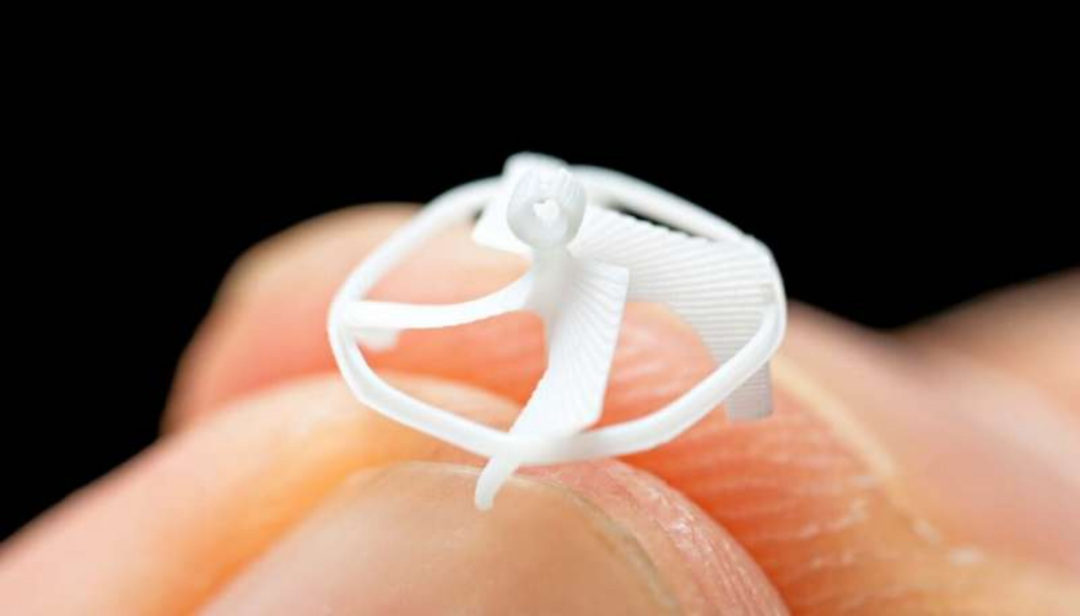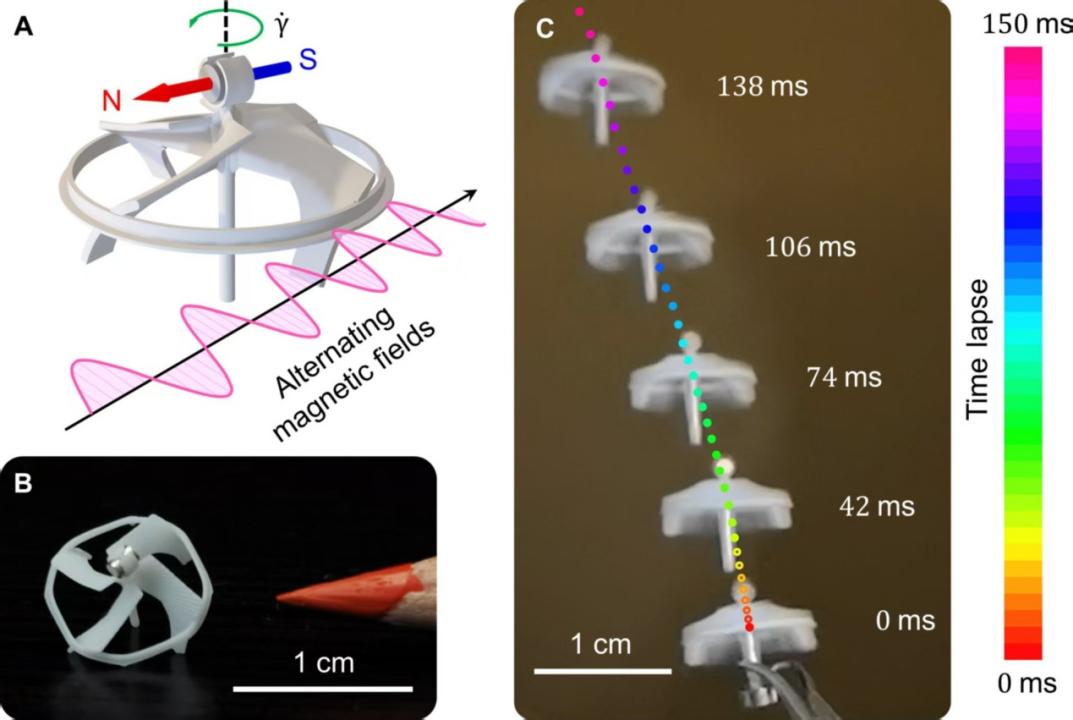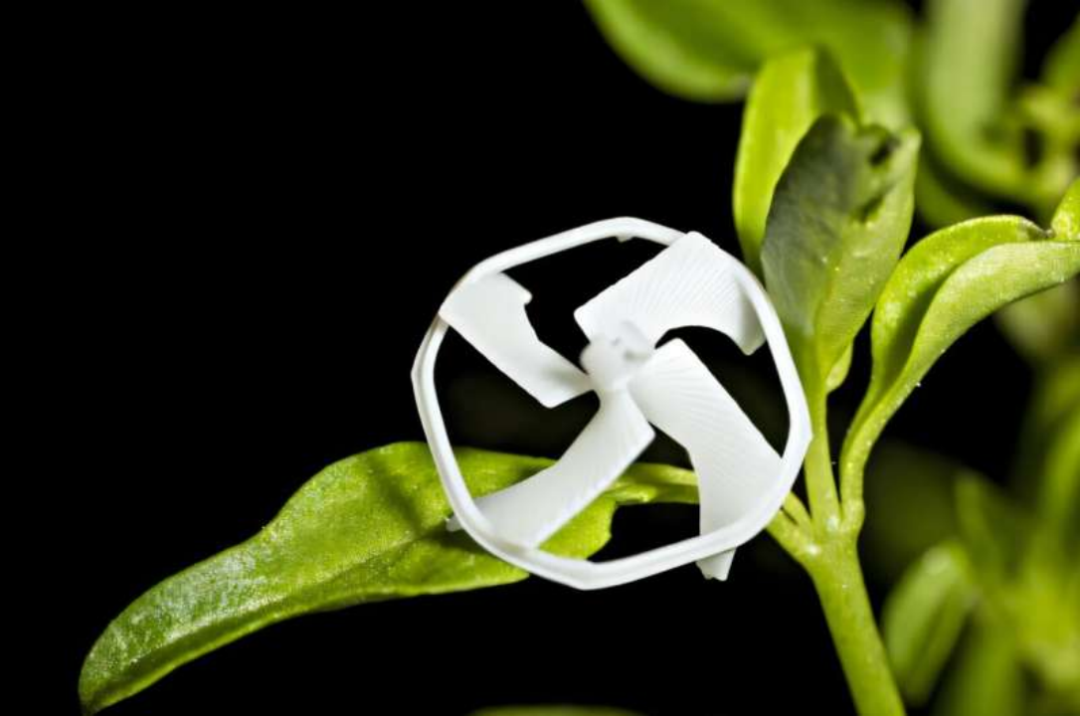 Micro flying vehicles have significant advantages in exploring complex environments such as confined spaces. After decades of research, the core challenges in the development of micro flying robots have always focused on the synergistic balance of energy supply strategies, propulsion efficiency, and aerodynamic performance.Recently, a team from the University of California, Berkeley, made a breakthrough inspired by the flight mechanisms of insects, successfully developing an ultra-micro wireless flying vehicle with a wingspan of only 9.4 millimeters and weighing 21 milligrams. This device can achieve hovering, trajectory adjustment, and even precise target impact, making it the world’s smallest wireless robot with controllable flight capabilities. The related paper was published in the latest issue of Science Advances.“In nature, the navigation, hovering, and pollination abilities exhibited by bees far exceed the performance limits of artificial flying vehicles of the same size,” said project leader Professor Liwei Lin from the Department of Mechanical Engineering at UC Berkeley. “This robot can accurately strike designated targets through wireless control, simulating the biomechanical mechanisms of bees collecting nectar and pollinating.”
Micro flying vehicles have significant advantages in exploring complex environments such as confined spaces. After decades of research, the core challenges in the development of micro flying robots have always focused on the synergistic balance of energy supply strategies, propulsion efficiency, and aerodynamic performance.Recently, a team from the University of California, Berkeley, made a breakthrough inspired by the flight mechanisms of insects, successfully developing an ultra-micro wireless flying vehicle with a wingspan of only 9.4 millimeters and weighing 21 milligrams. This device can achieve hovering, trajectory adjustment, and even precise target impact, making it the world’s smallest wireless robot with controllable flight capabilities. The related paper was published in the latest issue of Science Advances.“In nature, the navigation, hovering, and pollination abilities exhibited by bees far exceed the performance limits of artificial flying vehicles of the same size,” said project leader Professor Liwei Lin from the Department of Mechanical Engineering at UC Berkeley. “This robot can accurately strike designated targets through wireless control, simulating the biomechanical mechanisms of bees collecting nectar and pollinating.” Operating principle of the wireless sub-centimeter flying robot(A) Schematic diagram of the single-axis magnetic field power supply scheme. (B) Optical image comparing the 21-milligram prototype with a pencil, with a wingspan of 9.4 millimeters. (C) Time-lapse optical images of the robot’s continuous rotational motion and stable attitude during takeoff (maintaining a vertical posture throughout and increasing vertical speed over time). Solid points represent experimental measured data, while hollow circles represent interpolated calculation results.This breakthrough is attributed to the researchers’ clever solutions to two major technical bottlenecks—power supply and miniaturization of the flight control system. The development team innovatively uses an external magnetic field to simultaneously achieve power supply and heading control. This propeller-shaped robot is equipped with two micro magnets, which drive the blades to rotate through the alternating action of the external magnetic field, generating sufficient lift in a strong magnetic field environment, allowing the robot to take off successfully. By precisely adjusting the magnetic field strength, the flight trajectory can be controlled.However, currently, this robot still has certain control limitations and requires a strong magnetic field for effective control.
Operating principle of the wireless sub-centimeter flying robot(A) Schematic diagram of the single-axis magnetic field power supply scheme. (B) Optical image comparing the 21-milligram prototype with a pencil, with a wingspan of 9.4 millimeters. (C) Time-lapse optical images of the robot’s continuous rotational motion and stable attitude during takeoff (maintaining a vertical posture throughout and increasing vertical speed over time). Solid points represent experimental measured data, while hollow circles represent interpolated calculation results.This breakthrough is attributed to the researchers’ clever solutions to two major technical bottlenecks—power supply and miniaturization of the flight control system. The development team innovatively uses an external magnetic field to simultaneously achieve power supply and heading control. This propeller-shaped robot is equipped with two micro magnets, which drive the blades to rotate through the alternating action of the external magnetic field, generating sufficient lift in a strong magnetic field environment, allowing the robot to take off successfully. By precisely adjusting the magnetic field strength, the flight trajectory can be controlled.However, currently, this robot still has certain control limitations and requires a strong magnetic field for effective control. At this stage, the robot has not yet been equipped with environmental perception sensors and can only perform passive flight tasks, unable to autonomously adjust its posture; sudden air currents may cause deviations in its flight path. The research team is working on developing an active control system, planning to achieve real-time posture adjustments by integrating micro sensors.The existing device relies on a strong magnetic field generated by electromagnetic coils to operate, but researchers have proposed a forward-looking idea: if the robot’s size can be further reduced to below 1 millimeter (approaching the size of a mosquito), future weak magnetic fields provided by radio waves could control it. Notably, the team is also developing a cockroach-inspired crawling robot that has anti-tread capabilities, and its 5-millimeter “swarm” robot system can achieve complex cooperative behaviors such as crawling, rolling, rotating, and chain combinations.“These micro robots may one day be applied in minimally invasive surgical scenarios—by injecting a large number of micro robots into the body, they could collaboratively complete delicate medical operations such as stent construction and thrombus ablation,” the researchers envision. As the wireless driving mechanism and control system continue to be optimized, the technical boundaries of sub-centimeter flying robots are being constantly pushed, and their miniaturization process is moving closer to biological prototypes.Paper information: Fanping Sui et al, Untethered subcentimeter flying robots, Science Advances (2025). DOI: 10.1126/sciadv.ads6858
At this stage, the robot has not yet been equipped with environmental perception sensors and can only perform passive flight tasks, unable to autonomously adjust its posture; sudden air currents may cause deviations in its flight path. The research team is working on developing an active control system, planning to achieve real-time posture adjustments by integrating micro sensors.The existing device relies on a strong magnetic field generated by electromagnetic coils to operate, but researchers have proposed a forward-looking idea: if the robot’s size can be further reduced to below 1 millimeter (approaching the size of a mosquito), future weak magnetic fields provided by radio waves could control it. Notably, the team is also developing a cockroach-inspired crawling robot that has anti-tread capabilities, and its 5-millimeter “swarm” robot system can achieve complex cooperative behaviors such as crawling, rolling, rotating, and chain combinations.“These micro robots may one day be applied in minimally invasive surgical scenarios—by injecting a large number of micro robots into the body, they could collaboratively complete delicate medical operations such as stent construction and thrombus ablation,” the researchers envision. As the wireless driving mechanism and control system continue to be optimized, the technical boundaries of sub-centimeter flying robots are being constantly pushed, and their miniaturization process is moving closer to biological prototypes.Paper information: Fanping Sui et al, Untethered subcentimeter flying robots, Science Advances (2025). DOI: 10.1126/sciadv.ads6858
For business cooperation inquiries, promotional activities, and reprint requests, please contact: 18355423366 (WeChat same number) for coordination.
END
 ●Academician Sun Lining: Micro-nano perception empowers the innovative development of embodied intelligent robots●Professor Xiong Rong from Zhejiang University: Challenges and progress in the development of embodied intelligence in humanoid robots●Robot Technology and Applications 2025 Issue 1 (Total Issue 223)●Director Dong Kai: Trend analysis of the development of embodied intelligent robots●New breakthroughs in bionic robot technology: Learning from squirrels to navigate complex terrains●From “breaking the norm to listing” to tripling market value, Yujian Technology leads the Hong Kong stock robot track●Humanoid robot mass production explosion: Price wars heat up, industrial restructuring and social imagination under the technological revolution●Highlights: Robot concept listed companies generally under pressure in the first half of 2024, opportunities arise as robots and AI converge●Highlights from the 2023 annual reports of 55 listed robot companies: mixed results, intensified reshuffling●A comprehensive overview of China’s humanoid robot R&D teams●Under the heat of humanoid robots, the struggle between advancement and resistance●Who is the most eye-catching? Highlights from the mid-2023 reports of 53 listed robot companies●Download the semi-annual reports of 53 listed robot companies (with PDF) ●Interview with Zhao Mingguo from Tsinghua University: Accelerating evolution to replicate Boston Dynamics’ movements, what we need is confidence and innovation!●The preliminary results of the 2023 National Science and Technology Awards have been announced! Nine 985 universities are on the list! XJTU and Huazhong University of Science and Technology are in the top three! (with full list)●Unprecedented! American engineers collaborate with ChatGPT4 to design artificial intelligence chips●Russian President Putin approves the new version of the “2030 National Strategy for Artificial Intelligence Development”●How did the small Danish town of Odense, with a population of less than 200,000, become a global robot center?●“The year of commercialization” begins, and new players in humanoid robots are emerging●Swiss researchers develop a new type of artificial muscle, lighter, safer, and stronger!●The EU terminates Amazon’s acquisition of iRobot, what will happen to the former giant in the vacuum robot industry?●2023’s top ten news in the robotics industry●Muscle tissue-driven bipedal robots emerge, a breakthrough in biohybrid robotics!●Professionals discuss the robot-as-a-service model—the future of automation●Academician report|Pan Yunhe: Behavioral intelligence and product intelligence in artificial intelligence●Academician discusses new driving forces for promoting collaborative intelligent manufacturing in robotics●Academician discusses six key technologies for innovative design in robotics●Ximu Technology broadens new perspectives in humanoid robot research●Academician discusses the dual driving model for future artificial intelligence development●Academician discusses how intelligent mechanisms bring “Transformers” from the screen to reality
●Academician Sun Lining: Micro-nano perception empowers the innovative development of embodied intelligent robots●Professor Xiong Rong from Zhejiang University: Challenges and progress in the development of embodied intelligence in humanoid robots●Robot Technology and Applications 2025 Issue 1 (Total Issue 223)●Director Dong Kai: Trend analysis of the development of embodied intelligent robots●New breakthroughs in bionic robot technology: Learning from squirrels to navigate complex terrains●From “breaking the norm to listing” to tripling market value, Yujian Technology leads the Hong Kong stock robot track●Humanoid robot mass production explosion: Price wars heat up, industrial restructuring and social imagination under the technological revolution●Highlights: Robot concept listed companies generally under pressure in the first half of 2024, opportunities arise as robots and AI converge●Highlights from the 2023 annual reports of 55 listed robot companies: mixed results, intensified reshuffling●A comprehensive overview of China’s humanoid robot R&D teams●Under the heat of humanoid robots, the struggle between advancement and resistance●Who is the most eye-catching? Highlights from the mid-2023 reports of 53 listed robot companies●Download the semi-annual reports of 53 listed robot companies (with PDF) ●Interview with Zhao Mingguo from Tsinghua University: Accelerating evolution to replicate Boston Dynamics’ movements, what we need is confidence and innovation!●The preliminary results of the 2023 National Science and Technology Awards have been announced! Nine 985 universities are on the list! XJTU and Huazhong University of Science and Technology are in the top three! (with full list)●Unprecedented! American engineers collaborate with ChatGPT4 to design artificial intelligence chips●Russian President Putin approves the new version of the “2030 National Strategy for Artificial Intelligence Development”●How did the small Danish town of Odense, with a population of less than 200,000, become a global robot center?●“The year of commercialization” begins, and new players in humanoid robots are emerging●Swiss researchers develop a new type of artificial muscle, lighter, safer, and stronger!●The EU terminates Amazon’s acquisition of iRobot, what will happen to the former giant in the vacuum robot industry?●2023’s top ten news in the robotics industry●Muscle tissue-driven bipedal robots emerge, a breakthrough in biohybrid robotics!●Professionals discuss the robot-as-a-service model—the future of automation●Academician report|Pan Yunhe: Behavioral intelligence and product intelligence in artificial intelligence●Academician discusses new driving forces for promoting collaborative intelligent manufacturing in robotics●Academician discusses six key technologies for innovative design in robotics●Ximu Technology broadens new perspectives in humanoid robot research●Academician discusses the dual driving model for future artificial intelligence development●Academician discusses how intelligent mechanisms bring “Transformers” from the screen to reality Contact Us· WeChat ID: hszht2025· Contact Number: 18100123515
Contact Us· WeChat ID: hszht2025· Contact Number: 18100123515